International Journal of Intelligent Systems and Applications @ijisa
Статьи журнала - International Journal of Intelligent Systems and Applications
Все статьи: 1214
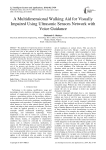
Статья научная
The application of engineering practices in medicine has immensely contributed to the recent findings in biomedical research areas. One of the products of this application is the development of sophisticated aids for physically challenged people. In this paper, visually impaired walking aid is designed and implemented using a network of ultrasonic sensors, thereby capable of detecting the direction and position of obstacle(s). The performance and functionality are also improved by the addition of alert light, and voice guidance signal which is relayed to a miniature headset. The recorded voice alerts the user of the presence and direction of the obstacle(s). The prototype of the multidimensional walking aid was able to detect obstacles within the range of 0m to 1m at the left, right and front of the stick with an appropriate voice alert. The test results of the prototype showed that the stick can efficiently guide its user.
Бесплатно
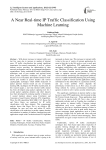
A Near Real-time IP Traffic Classification Using Machine Learning
Статья научная
With drastic increase in internet traffic over last few years due to increase in number of internet users, IP traffic classification has gained significant importance for research community as well as various internet service providers for optimization of their network performance and for governmental intelligence organizations. Today, traditional IP traffic classification techniques such as port number and payload based direct packet inspection techniques are rarely used because of use of dynamic port number instead of well-known port number in packet headers and various cryptographic techniques which inhibit inspection of packet payload. Current trends are use of machine learning (ML) techniques for IP traffic classification. In this research paper, a real time internet traffic dataset has been developed using packet capturing tool for 2 second packet capturing duration and other datasets have been developed by reducing number of features of 2 second duration dataset using Correlation and Consistency based Feature Selection (FS) Algorithms. Then, five ML algorithms MLP, RBF, C4.5, Bayes Net and Naïve Bayes are employed for IP traffic classification with these datasets. This experimental analysis shows that Bayes Net is an effective ML technique for near real time and online IP traffic classification with reduction in packet capture duration and reduction in number of features characterizing each application sample with Correlation based FS Algorithm.
Бесплатно
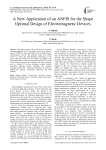
A New Application of an ANFIS for the Shape Optimal Design of Electromagnetic Devices
Статья научная
This paper presents a new model based on simulated annealing algorithm (ASA) and adaptive neuro-fuzzy inference system (ANFIS) for shape optimization and its applications to electromagnetic devices. The proposed model uses ANFIS system to evaluate the electromagnetic performance of the device. Both the ANFIS and ASA method are applied to the design/optimization of the electromagnetic actuator. The results of the proposed approach are compared with other techniques such as: method of moving asymptotes, penalty method, augmented lagrangian genetic algorithm and simulated annealing method (SA). Among the algorithms, the proposed ANFIS-ASA approach significantly outperforms the other methods.
Бесплатно
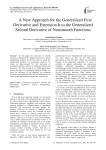
Статья научная
In this paper, first derivative of smooth function is defined by the optimal solution of a special optimization problem. In the next step, by using this optimization problem for nonsmooth function, we obtain an approximation for first derivative of nonsmooth function which it is called generalized first derivative. We then extend it to define generalized second derivative for nonsmooth function. Finally, we show the efficiency of our approach by evaluating derivative and generalized first and second derivative of some smooth and nonsmooth functions, respectively.
Бесплатно
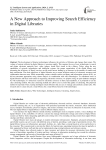
A New Approach to Improving Search Efficiency in Digital Libraries
Статья научная
The development of Internet technologies influences the activities of libraries and changes their nature. The volume of content collected in digital libraries is growing rapidly. This requires the use of new technologies to search and obtain electronic materials (text, video, images, sound files) stored in the e-library. Today, using the new capabilities of network technologies and intelligent systems, the proper organization of the digital library, and increasing the efficiency of library services are the main factors leading to an increase in the number of readers and their satisfaction. The main objectives of digital libraries are to ensure efficient retrieval of electronic resources and collaboration between users. While researching various scientific articles on library and information sciences (LIS), we did not encounter approaches using cluster analysis in combination with wiki technologies. To collaborate users in digital libraries and their involvement in organizing electronic resources, we propose using an open database managed by wiki technologies. To effectively search for electronic resources in these open databases, it is proposed to use the clear clustering method. The clear clustering method also allows you to control the quality of clustering. The proposed method is important when creating intelligent (smart) libraries that are easy to manage and automate certain tasks. The research aims to create not just a smart library, but a smart library based on wiki technologies.
Бесплатно
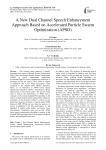
Статья научная
This research paper proposes a recently developed new variant of Particle Swarm Optimization (PSO) called Accelerated Particle Swarm Optimization (APSO) in speech enhancement application. Accelerated Particle Swarm Optimization technique is developed by Xin she Yang in 2010. APSO is simpler to implement and it has faster convergence when compared to the standard PSO (SPSO) algorithm. Hence as an alternative to SPSO based speech enhancement algorithm, APSO is introduced to speech enhancement in the present paper. The present study aims to analyze the performance of APSO and to compare it with existing standard PSO algorithm, in the context of dual channel speech enhancement. Objective evaluation of the proposed method is carried out by using three objective measures of speech quality SNR, Improved SNR, PESQ and one objective measure of speech intelligibility FAI. The performance of the algorithm is studied under babble and factory noise environments. Simulation result proves that APSO based speech enhancement algorithm is superior to the standard PSO based algorithm with an improved speech quality and intelligibility measures.
Бесплатно
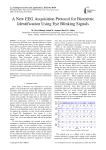
A New EEG Acquisition Protocol for Biometric Identification Using Eye Blinking Signals
Статья научная
In this paper, a new acquisition protocol is adopted for identifying individuals from electroencephalogram signals based on eye blinking waveforms. For this purpose, a database of 10 subjects is collected using Neurosky Mindwave headset. Then, the eye blinking signal is extracted from brain wave recordings and used for the identification task. The feature extraction stage includes fitting the extracted eye blinks to auto-regressive model. Two algorithms are implemented for auto-regressive modeling namely; Levinson-Durbin and Burg algorithms. Then, discriminant analysis is adopted for classification scheme. Linear and quadratic discriminant functions are tested and compared in this paper. Using Burg algorithm with linear discriminant analysis, the proposed system can identify subjects with best accuracy of 99.8%. The obtained results in this paper confirm that eye blinking waveform carries discriminant information and is therefore appropriate as a basis for person identification methods.
Бесплатно
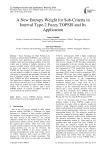
A New Entropy Weight for Sub-Criteria in Interval Type-2 Fuzzy TOPSIS and Its Application
Статья научная
Fuzzy Technique for Order Preference by Similarly to Ideal Solution (TOPSIS) is one of the most commonly used approaches in solving numerous multiple criteria decision making problems. It has been widely used in ranking of multiple alternatives with respect to multiple criteria with the superiority of fuzzy set type-1 and subjective weights. Recently, fuzzy TOPSIS has been merged with interval type-2 fuzzy sets and subjective weights for criteria as to handle the wide arrays of vagueness and uncertainty. However, the role of objective weights in this new interval type-2 fuzzy TOPSIS has given considerably less attention. This paper aims to propose a new objective weight for sub-criteria in interval type-2 fuzzy TOPSIS. Instead of using weight for criteria, this paper considers entropy weights for sub-criteria in interval type-2 fuzzy TOPSIS method. An example of supplier selection is used to illustrate the proposed method.
Бесплатно
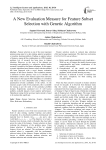
A New Evaluation Measure for Feature Subset Selection with Genetic Algorithm
Статья научная
Feature selection is one of the most important preprocessing steps for a data mining, pattern recognition or machine learning problem. Finding an optimal subset of features, among all the combinations is a NP-Complete problem. Lot of research has been done in feature selection. However, as the sizes of the datasets are increasing and optimality is a subjective notion, further research is needed to find better techniques. In this paper, a genetic algorithm based feature subset selection method has been proposed with a novel feature evaluation measure as the fitness function. The evaluation measure is different in three primary ways a) It considers the information content of the features apart from relevance with respect to the target b) The redundancy is considered only when it is over a threshold value c) There is lesser penalization towards cardinality of the subset. As the measure accepts value of few parameters, this is available for tuning as per the need of the particular problem domain. Experiments conducted over 21 well known publicly available datasets reveal superior performance. Hypothesis testing for the accuracy improvement is found to be statistically significant.
Бесплатно
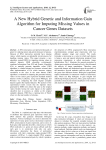
Статья научная
A DNA microarray can represent thousands of genes for studying tumor and genetic diseases in humans. Datasets of DNA microarray normally have missing values, which requires an undeniably crucial process for handling missing values. This paper presents a new algorithm, named EMII, for imputing missing values in medical datasets. EMII algorithm evolutionarily combines Information Gain (IG) and Genetic Algorithm (GA) to mutually generate imputable values. EMII algorithm is column-oriented not instance oriented than other implementation of GA which increases column correlation to the class in the same dataset. EMII algorithm is evaluated for imputing the generated missing values in four cancer gene expression standard medical datasets (Colon, Leukemia, Lung cancer-Michigan, and Prostate) via comparing the truth original complete datasets against the imputed datasets. The analysis of the experimental results reveals that the imputed values generated by EMII were almost the same as the original values besides having the same impact on the applied classifiers due to accuracy as similar as the original complete datasets. EMII has a running time of θ(n2), where n is the total number of columns.
Бесплатно
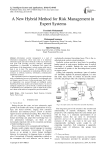
A New Hybrid Method for Risk Management in Expert Systems
Статья научная
Information security management is a part of information management, whose main task is to determine information goals and remove obstacles on the way of achieving such goals with providing necessary strategies. Information management is responsible to implement and control the performance of the organization`s security system while tries to keep it up to date. The purpose of information security management in an organization is maintaining different sorts of resources as software, hardware, information, communication and human resources. The organization needs an integrated program against threats such as unauthorized access to information, environmental risks and dangers caused by users. In the present paper, the IT risk in an organization was assessed through an intelligent system benefiting from fuzzy analysis and certainty factors. As most of ambiguity samples have a level of belie, so doubt and the degree of membership were calculated as a part of output in the system and a better result achieved compared to previous methods.
Бесплатно
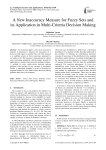
A New Inaccuracy Measure for Fuzzy Sets and its Application in Multi-Criteria Decision Making
Статья научная
In the present paper, a new fuzzy inaccuracy measure is proposed to measure the inaccuracy of a fuzzy set with respect to another fuzzy set. This measure is a modified version of fuzzy inaccuracy proposed in our earlier work. The measure is demonstrated to satisfy some interesting properties, which prepare ground for applications in multi-criteria decision making problems. A method to solve multi-criteria decision making problems with the help of new measure is developed. Finally, a numerical example is given to illustrate the proposed method to solve multi-criteria decision-making problem under fuzzy environment.
Бесплатно
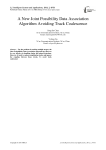
A New Joint Possibility Data Association Algorithm Avoiding Track Coalescence
Статья научная
For the problem of tracking multiple targets, the Joint Probabilistic Data Association approach has shown to be very effective in handling clutter and missed detections. However, it tends to coalesce neighboring tracks and ignores the coupling between those tracks. To avoid track coalescence,a K Nearest Neighbor Joint Probabilistic Data Association algorithm is proposed in this paper. Like the Joint Probabilistic Data Association algorithm, the association possibilities of target with every measurement will be computed in the new algorithm, but only the first K measurements whose association probabilities with the target are larger than others’ are used to estimate target’s state. Finally, through Monte Carlo simulations, it is shown that the new algorithm is able to avoid track coalescence and keeps good tracking performance in heavy clutter and missed detections.
Бесплатно
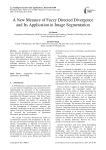
A New Measure of Fuzzy Directed Divergence and Its Application in Image Segmentation
Статья научная
An approach to develop new measures of fuzzy directed divergence is proposed here. A new measure of fuzzy directed divergence is proposed, and some mathematical properties of this measure are proved. The application of fuzzy directed divergence in image segmentation is explained. The proposed technique minimizes the fuzzy divergence or the separation between the actual and ideal thresholded image.
Бесплатно
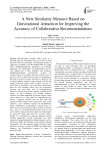
Статья научная
Recommender Systems (RSs) work as a personal agent for individuals who are not able to make decisions from the potentially overwhelming number of alternatives available on the World Wide Web (or simply Web). Neighborhood-based algorithms are traditional approaches for collaborative recommendations and are very popular due to their simplicity and efficiency. Neighborhood-based recommender systems use numerous kinds of similarity measures between users or items in order to achieve diverse goals for designing an RS such as accuracy, novelty, diversity etc. However, the existing similarity measures cannot manage well the data sparsity problems, which results in either very few co-rated items or absolutely no co-rated items. Furthermore, there are also situations where only the associations between users and items, such as buying/browsing behaviors, exist in form of unary ratings, a special case of ratings. In such situations, the existing similarity measures are either undefined or provide extreme values such as either 0 or 1. Thus, there is a compelling need to define a similarity measure that can deal with data sparsity problem and/or unary rating data. This article proposes a new similarity measure for neighborhood-based collaborative recommender systems based on Newton's law of universal gravitation. In order to achieve this, a new way of interpreting the relative mass as well as the relative distance has been taken into consideration by using the rating data from the user-item matrix. Finally, for evaluating the proposed approach against baseline approaches, several experiments have been conducted using standardized benchmark datasets such as MovieLens-100K and MovieLens-1M. Results obtained demonstrate that the proposed method provides better predictive accuracy in terms of RMSE and significantly improves the classification accuracy in terms of precision-recall.
Бесплатно
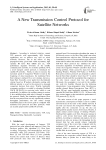
A New Transmission Control Protocol for Satellite Networks
Статья научная
According to technical statistics, current TCP protocols with approximately 80% Internet applications run on perform very well on wired networks. However, due to the effects of long propagation delay, great band- width asymmetry, high sporadic Bit Error Rate (BER) and etc., TCP performance degrades obviously on the satellite communication networks. To avoid the problems, TP-S, a novel transport control protocol, is introduced for satellite IP networks. Firstly, in order to increase the increment speed of Congestion Window (cwnd) at the beginning of data transmission, the traditional Slow Start strategy is replaced by a new strategy, known as Super Start. Secondly, a new packet lost discriminated scheme based on IP packets alternately sending with different priority is used in the protocol to decouple congestion decision from errors. Thirdly, bandwidth asymmetry problem is avoided by adopting Modified NACK (M-NACK) in receiving ends, which is sent periodically. In addition, the sending strategy in routers is also modified along with other’s changes to support the protocol. Finally, the simulation experiments show that the new protocol can not only significantly enhance throughput performance, but also reduce sharply bandwidth used in the reverse path as compared with traditional TCP protocols and those protocols, which are recently proposed for satellite IP networks.
Бесплатно
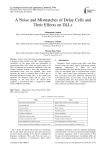
A Noise and Mismatches of Delay Cells and Their Effects on DLLs
Статья научная
Jitter is one of the most important parameters in design of delay locked loop (DLL) based frequency synthesizer. In this paper noise and mismatches of conventional delay cells which are mainly used in the DLLs architecture are introduced completely. First, time domain equations related to noise and mismatches of conventional delay cells are reported. Then, these equations are used to calculate jitter of DLL due to mismatch and noise of delay cells. At last closed form equations are obtained which can be used in the designing of low jitter DLLs. To validate these equations, a conventional DLL is designed in TSMC 0.18um CMOS Technology.
Бесплатно
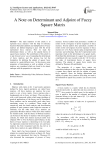
A Note on Determinant and Adjoint of Fuzzy Square Matrix
Статья научная
The main intention of this article is to represent fuzzy matrices with the help of reference function.Thereafter addition and multiplication of fuzzy matrices are defined keeping in pace with the newly represented fuzzy matrices. Here we study the determinant theory as well as the adjoint theory of square fuzzy matrices. The contribution of this article is to put forward a new way of expanding the determinant of fuzzy matrices and this process has led the foundation for defining the adjoint of square fuzzy matrices in a quite different way. In the process some properties of determinant as well as adjoint of fuzzy matrices are considered which are found to be almost analogus with the properties in crisp cases.
Бесплатно
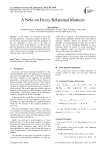
A Note on Fuzzy Relational Matrices
Статья научная
In this article, we would like to revisit the existing definitions of cartesian product of fuzzy sets and the fuzzy relational matrix from the standpoint of the new definition of fuzzy sets on the basis of reference function. In the process it is observed that there are drawbacks in the current defintions and hence new definitions of terms mentioned are proposed in this article. Some numerical examples are also presented to make the matter clear and simple.
Бесплатно
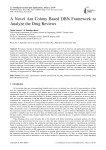
A Novel Ant Colony Based DBN Framework to Analyze the Drug Reviews
Статья научная
Nowadays, big data is directing the entire advanced world with its function and applications. Moreover, to make better decisions from the ever emerging big data belonging to the respective organizations, deep learning (DL) models are required. DL is also widely used in the sentiment classification tasks considering data from social networks. Furthermore, sentiment classification signifies the best way to analyze the big data and make decisions accordingly. Analyzing the sentiments from big data applications is quite challenging task and also requires more time for the execution process. Therefore, to analyze and classify big data emerging from social networks in a better way, DL models are utilized. DL techniques are being used among the researchers to get high end results. A novel Ant Colony-based Deep Belief Neural Network (AC-DBN) framework is proposed in this research. Drug review tweets are opted to perform sentiment classification by using the proposed framework in python environment. A model fitness function is initiated in the DL framework and is observed that it is attaining high accuracy with low computation time. Additionally, the obtained results attained from the proposed framework are validated with existing methods for evaluating the efficiency of the proposed AC-DBN approach.
Бесплатно

